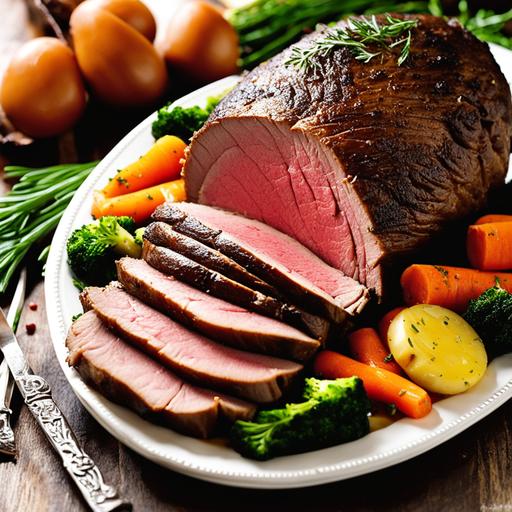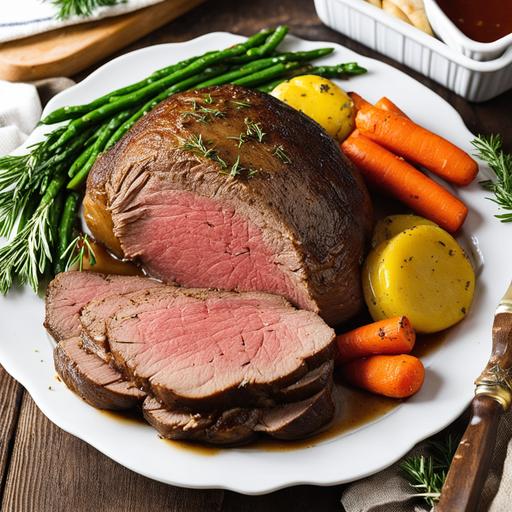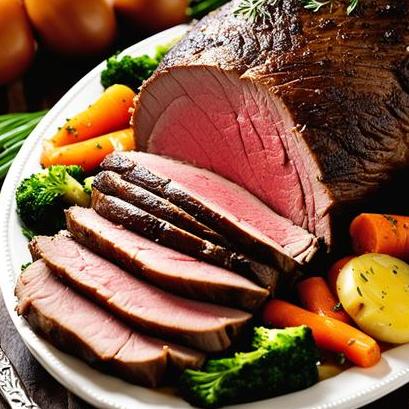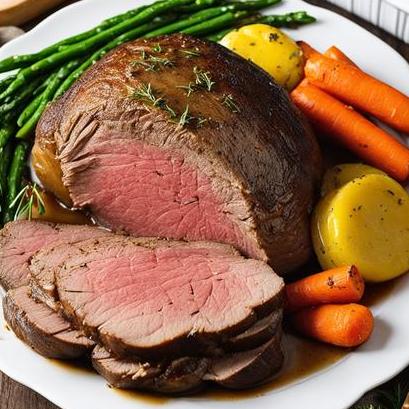- You are here:
- Home »
- Oven Recipes
- » The Perfect Round Roast Oven Recipe

The Perfect Round Roast Oven Recipe
The round roast is a classic cut of beef that can be transformed into a succulent, flavorful dish when cooked properly. One of the most reliable methods for cooking round roast is in the oven. This method allows for even cooking and optimal flavor retention. In this comprehensive guide, we’ll delve into the food science behind cooking round roast in an oven, explore the importance of ingredient selection and preparation, and provide a step-by-step recipe for creating a delicious round roast in your own kitchen.
Food Science Of Cooking Round Roast In An Oven
Understanding the science behind cooking round roast in an oven is crucial for achieving the desired results. Round roast comes from the rear leg of the cow and contains a significant amount of connective tissue and collagen. These tough fibers can make the meat chewy if not cooked properly. However, when cooked at the right temperature for the correct amount of time, these connective tissues break down, resulting in tender, juicy meat.
The key to tenderizing round roast is slow, gentle cooking at a low temperature. This allows the collagen to gradually melt into gelatin, resulting in a tender texture. Additionally, using moist heat during cooking helps to keep the meat juicy and prevents it from drying out.
Choosing Ingredients
Selecting the right ingredients is essential for creating a delicious round roast. When choosing a round roast, look for a cut that is well-marbled with fat. This intramuscular fat adds flavor and moisture to the meat during cooking. Additionally, choose a roast that is uniform in size and shape, as this will ensure even cooking.
In addition to the roast itself, you’ll need a few simple ingredients to season and flavor the meat. Common seasonings for round roast include salt, pepper, garlic, and herbs such as rosemary or thyme. You may also choose to add aromatics such as onions, carrots, and celery to enhance the flavor of the roast.
Preparing Ingredients

Properly preparing the ingredients is essential for ensuring a delicious round roast. Start by trimming any excess fat from the roast, leaving just enough to add flavor and moisture during cooking. Next, season the roast generously with salt, pepper, and any other desired seasonings, rubbing them into the meat to ensure even distribution.
If desired, you can also sear the roast before cooking it in the oven. Searing the meat creates a flavorful crust and helps to lock in moisture. To sear the roast, heat a skillet or Dutch oven over high heat and add a small amount of oil. Once the oil is hot, add the roast and sear it on all sides until browned.
Optimal Oven Cooking Temperature & Timing
Cooking round roast in the oven requires careful attention to temperature and timing to achieve the perfect result. For tender, juicy meat, it’s best to cook the roast at a low temperature over a longer period of time. A temperature of around 275°F (135°C) is ideal for slow-roasting round roast.
The cooking time will vary depending on the size and thickness of the roast, but as a general rule of thumb, plan for approximately 20 minutes of cooking time per pound of meat. Use a meat thermometer to ensure that the internal temperature of the roast reaches 145°F (63°C) for medium-rare or 160°F (71°C) for medium.
Round Roast Oven Recipe
Now that you understand the science behind cooking round roast in an oven and have selected and prepared your ingredients, it’s time to put it all together and create a delicious roast beef dinner. Follow this step-by-step recipe for perfect results every time:
Ingredients
- 1 (3-4 pound) round roast
- Salt and pepper to taste
- 2 cloves garlic, minced
- 1 tablespoon olive oil
- Optional: Fresh herbs such as rosemary or thyme
- Optional: Aromatics such as onions, carrots, and celery
Instructions
- Preheat your oven to 275°F (135°C).
- Trim any excess fat from the round roast and season it generously with salt, pepper, and minced garlic. If desired, you can also rub the roast with fresh herbs such as rosemary or thyme.
- Optional: Heat a skillet or Dutch oven over high heat and add the olive oil. Once the oil is hot, add the roast and sear it on all sides until browned.
- If using aromatics, place them in the bottom of a roasting pan and place the seasoned roast on top.
- Place the roast in the preheated oven and cook for approximately 20 minutes per pound, or until the internal temperature reaches 145°F (63°C) for medium-rare or 160°F (71°C) for medium.
- Once cooked to your desired doneness, remove the roast from the oven and let it rest for at least 10 minutes before slicing.
- Slice the roast against the grain and serve with your favorite side dishes.
Cooking round roast in the oven is a straightforward process that yields delicious results. By understanding the science behind cooking this cut of meat, selecting high-quality ingredients, and following proper preparation and cooking techniques, you can create a tender, flavorful roast beef dinner that will impress your family and guests. Experiment with different seasonings and cooking methods to customize the recipe to your taste preferences, and enjoy the satisfaction of mastering this classic dish.
Doneness Checks

Round roast, sourced from the rear leg of the cow, is a cut known for its rich flavor and tenderness when cooked properly. When prepared in the oven, this roast can be transformed into a delectable centerpiece for any meal. The key to a perfect round roast lies in mastering the cooking process, from selecting the right cut to seasoning, roasting, and achieving the desired level of doneness.
Before we dive into the cooking process, it’s essential to understand the various factors that can affect the outcome of your round roast. These include the quality of the meat, the cooking temperature, and the internal temperature at which the roast is cooked to achieve your preferred level of doneness.
Checking the doneness of your round roast is crucial to ensure it’s cooked to perfection. Here are some methods you can use to determine the doneness of your roast:
1. Meat Thermometer
Using a meat thermometer is the most accurate way to check the internal temperature of your roast. Insert the thermometer probe into the thickest part of the meat, away from any bones or fat. The following are the recommended internal temperatures for various levels of doneness:
- Rare: 120-125°F (49-52°C)
- Medium Rare: 130-135°F (54-57°C)
- Medium: 140-145°F (60-63°C)
- Medium Well: 150-155°F (66-68°C)
- Well Done: 160°F (71°C) and above
2. Visual Inspection
Visual cues can also help determine the doneness of your roast:
- Rare: The meat will be bright red in the center.
- Medium Rare: The center will be pink with a slightly brown outer layer.
- Medium: The center will be pink, transitioning to light brown towards the edges.
- Medium Well: The center will be slightly pink, with more browning towards the edges.
- Well Done: The meat will be uniformly brown throughout.
3. Touch Test
Another method is the touch test, where you use your fingers to gauge the firmness of the meat:
- Rare: Feels soft and squishy, like the flesh between your thumb and forefinger when your hand is relaxed.
- Medium Rare: Feels slightly firmer, similar to the flesh at the base of your thumb when you touch your thumb to your pinky finger.
- Medium: Feels firmer, resembling the flesh at the base of your thumb when you touch your thumb to your ring finger.
- Medium Well: Feels quite firm, like the flesh at the base of your thumb when you touch your thumb to your middle finger.
- Well Done: Feels very firm, like the flesh at the base of your thumb when you touch your thumb to your index finger.
Undercooking
Undercooking your round roast can result in tough, chewy meat that lacks flavor and moisture. Here are some common reasons why your roast might be undercooked:
1. Insufficient Cooking Time
If you haven’t allowed enough time for your roast to cook thoroughly, it may still be undercooked when you remove it from the oven. Round roasts typically require a longer cooking time due to their dense texture and low fat content.
2. Low Oven Temperature
Cooking your roast at too low of a temperature can prolong the cooking process and result in undercooked meat. Make sure your oven is preheated to the appropriate temperature as specified in your recipe.
3. Incorrect Oven Placement
Placing your roast too close to the top or bottom of the oven can affect the cooking time and result in uneven cooking. Position your roast in the center of the oven for even heat distribution.
4. Inaccurate Thermometer Reading
If you rely solely on visual cues or inaccurate meat thermometers, you may misjudge the doneness of your roast and remove it from the oven too soon.
Overcooking
Overcooking your round roast can lead to dry, tough meat that lacks flavor and juiciness. Here are some common reasons why your roast might be overcooked:
1. Excessive Cooking Time
Leaving your roast in the oven for too long can cause it to become dry and tough. Keep an eye on the cooking time and use a meat thermometer to ensure your roast reaches the desired level of doneness without overcooking.
2. High Oven Temperature
Cooking your roast at too high of a temperature can cause the exterior to cook too quickly, resulting in an overcooked exterior and undercooked interior. Follow the temperature recommendations in your recipe for optimal results.
3. Improper Resting Period
Failing to allow your roast to rest properly after cooking can cause the juices to escape, resulting in dry meat. Let your roast rest for 10-15 minutes before carving to allow the juices to redistribute evenly.
4. Inaccurate Thermometer Placement
Inserting the meat thermometer into the wrong part of the roast or too close to the bone can give inaccurate readings, leading to overcooking.
Troubleshooting

Encountering issues with your round roast can be frustrating, but understanding common problems and how to fix them can help salvage your meal. Here are some troubleshooting tips:
1. Tough, Dry Meat
If your roast turns out tough and dry, it may have been overcooked. To salvage it, slice the meat thinly against the grain and serve it with a flavorful sauce or gravy to add moisture and enhance the taste.
2. Uneven Cooking
Uneven cooking can occur if your roast is not of uniform thickness or if the oven temperature is not consistent. To prevent this, choose a roast of uniform thickness and rotate it halfway through the cooking process to ensure even cooking.
3. Burnt Exterior
A burnt exterior can result from cooking your roast at too high of a temperature or leaving it in the oven for too long. To salvage it, carefully trim away the burnt portions and serve the remaining meat with a flavorful sauce or gravy.
4. Raw Center
If the center of your roast is still raw while the exterior is cooked, it may not have been allowed enough time to cook thoroughly. Return the roast to the oven and continue cooking until it reaches the desired level of doneness.
Recipe Variations
Now that you’re familiar with the cooking process and how to troubleshoot common issues, let’s explore some delicious recipe variations to elevate your round roast game:
1. Herb-Crusted Round Roast
- Rub the roast with a mixture of minced garlic, chopped fresh herbs (such as rosemary, thyme, and parsley), salt, and pepper.
- Roast in the oven until the internal temperature reaches your desired level of doneness.
2. Balsamic Glazed Round Roast
- Marinate the roast in a mixture of balsamic vinegar, olive oil, garlic, brown sugar, and Dijon mustard for several hours or overnight.
- Roast in the oven, basting with the marinade occasionally, until cooked to perfection.
3. Slow Cooker Round Roast
- Place the roast in a slow cooker and season with salt, pepper, and your favorite spices.
- Add vegetables such as carrots, potatoes, and onions, along with beef broth or red wine.
- Cook on low for 8-10 hours or until the meat is fork-tender.
4. Asian-Inspired Round Roast
- Marinate the roast in a mixture of soy sauce, ginger, garlic, sesame oil, and honey for several hours or overnight.
- Roast in the oven until cooked to your desired level of doneness, then slice thinly and serve with stir-fried vegetables and rice.
Mastering the art of cooking a round roast in the oven is a rewarding endeavor that can elevate your culinary skills and impress your guests. By following the tips and techniques outlined in this guide, you can ensure that your roast turns out tender, flavorful, and cooked to perfection every time. Whether you prefer a classic herb-crusted roast or a more adventurous Asian-inspired dish, the possibilities are endless. So, roll up your sleeves, preheat your oven, and prepare to embark on a mouthwatering culinary journey with round roast as your centerpiece.
Flavour Enhancement Tips
A round roast, cut from the hind leg of a cow, is a flavorful and versatile cut of meat that can be cooked in various ways. However, one of the most popular methods is oven roasting, which results in tender, juicy meat with a delicious crust.
To elevate the flavor of your round roast, consider incorporating the following tips:
1. Marinating
Marinating the meat before cooking can infuse it with extra flavor and tenderness. Choose a marinade that complements the natural richness of beef, such as a mixture of olive oil, garlic, fresh herbs, and citrus juice. Allow the roast to marinate for at least 4 hours or overnight in the refrigerator for maximum flavor penetration.
2. Seasoning Rub
Create a dry rub using a combination of spices, herbs, salt, and pepper. Apply the rub generously all over the surface of the roast, ensuring that every inch is coated evenly. This will create a flavorful crust as the roast cooks in the oven.
3. Garlic Infusion
For garlic lovers, consider inserting slivers of garlic into small incisions made throughout the roast. As the meat cooks, the garlic will release its aromatic oils, imparting a subtle yet savory flavor.
Texture Enhancement Tips

Achieving the perfect texture is essential for a succulent round roast. Here’s how to ensure your roast is tender and juicy:
1. Pre-searing
Before placing the roast in the oven, sear it on all sides in a hot skillet or Dutch oven. Searing caramelizes the exterior of the meat, locking in moisture and enhancing the overall flavor. Aim for a golden brown crust before transferring the roast to the oven.
2. Low And Slow Cooking
To tenderize the meat and ensure it remains juicy, opt for a low and slow cooking method. Set your oven to a low temperature, around 275°F to 300°F (135°C to 150°C), and roast the meat for an extended period. This gentle cooking process allows the connective tissues to break down gradually, resulting in a tender roast.
3. Resting Period
After removing the roast from the oven, allow it to rest for 10 to 15 minutes before slicing. This resting period allows the juices to redistribute throughout the meat, ensuring each slice is moist and flavorful.
Cooking At Different Temperatures
The cooking temperature plays a crucial role in determining the final outcome of your round roast. Here’s how to adjust the temperature based on your preferences:
1. Medium-Rare
For a medium-rare roast with a slightly pink center, aim for an internal temperature of 135°F to 140°F (57°C to 60°C). Remove the roast from the oven when the thermometer inserted into the thickest part reads within this range.
2. Medium
If you prefer your roast cooked to medium doneness, target an internal temperature of 145°F to 150°F (63°C to 66°C). Keep a close eye on the roast and remove it from the oven as soon as it reaches the desired temperature.
3. Well-Done
For those who prefer their meat well-done with no pinkness, cook the roast until it reaches an internal temperature of 160°F to 165°F (71°C to 74°C). Keep in mind that cooking the roast to this level of doneness may result in slightly drier meat.
Cooking Tips
Follow these additional tips to ensure your round roast turns out perfectly every time:
1. Use A Meat Thermometer
Invest in a reliable meat thermometer to accurately gauge the internal temperature of the roast. This will help prevent overcooking and ensure the meat is cooked to your desired level of doneness.
2. Basting
During the cooking process, periodically baste the roast with pan juices or melted butter to keep it moist and flavorful. Basting adds an extra layer of richness to the meat and helps to prevent it from drying out.
3. Positioning
Place the roast on a rack in a roasting pan to allow for even air circulation around the meat. This will promote uniform cooking and help prevent the bottom of the roast from becoming soggy.
Serving Suggestions
Once your round roast is perfectly cooked and rested, it’s time to serve it up! Here are some delicious serving suggestions:
1. Traditional Accompaniments
Serve the roast alongside classic side dishes such as mashed potatoes, roasted vegetables, and a rich gravy made from the pan drippings. This timeless combination never fails to impress.
2. Sandwiches
Slice the leftover roast thinly and use it to make hearty sandwiches. Layer the slices between crusty bread with your favorite condiments and toppings for a satisfying meal.
3. Salad Toppings
For a lighter option, thinly slice the roast and use it to top a bed of mixed greens for a flavorful salad. Add crumbled blue cheese, toasted nuts, and a tangy vinaigrette for a delicious contrast of flavors.
Conclusion
Mastering the art of cooking a round roast in the oven requires attention to detail and a few key techniques. By enhancing the flavor with marinades and seasonings, achieving the perfect texture through low and slow cooking, and mastering the cooking temperatures, you can create a mouthwatering roast that will impress your family and friends. With these tips and tricks, you’ll be well on your way to becoming a roast master in your own kitchen.
FAQS
What Is A Round Roast?
A round roast is a cut of beef from the rear leg of a cow. It is a lean and flavorful cut, perfect for roasting in the oven.
How Do I Prepare A Round Roast For Roasting?
Before roasting, it is recommended to season the round roast with salt, pepper, and any additional spices of your choice. You can also marinate it overnight for enhanced flavor. Remember to take the roast out of the refrigerator at least 30 minutes prior to cooking to allow it to come to room temperature.
What Is The Best Way To Cook A Round Roast In The Oven?
The best way to cook a round roast in the oven is to preheat it to a high temperature, such as 450°F (232°C), to create a seared crust. Then, reduce the temperature to around 325°F (163°C) and continue cooking until the internal temperature of the roast reaches your desired level of doneness. For a medium-rare roast, this would typically take about 20 minutes per pound.
How Can I Ensure A Tender Round Roast?
To ensure a tender round roast, it is essential to cook it to the correct internal temperature. Use a meat thermometer to monitor the roast’s temperature throughout the cooking process. Additionally, using a roasting rack to elevate the roast from its juices will help prevent it from becoming too saturated and potentially tough.
Should I Let The Round Roast Rest After Cooking?
Yes, it is highly advisable to let the round roast rest for about 15-20 minutes after you remove it from the oven. This allows the juices to redistribute throughout the meat, resulting in a more tender and flavorful roast. Tent the roast loosely with aluminum foil to keep it warm during the resting period.


